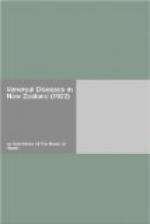On the same point Flexner says: “It is a truism that physicians requiring to equip themselves as specialists in venereal disease resort to the crowded clinics of Paris, Vienna, and Berlin, all regulated towns, because there disease is found in greatest abundance and richest variety—a strange comment on the alleged efficacy of regulation.”
Dr. Clarkson, in “The Venereal Clinic,” already quoted, says, in reference to the fancied security of licensed houses, “It may strengthen the hands of practitioners to be able to tell interrogators in this subject that in the opinion of leading venereologists, &c., no foundation exists for any such feeling of confidence or security. In other words, the system of licensed houses is a failure, and the ’red light’ of lust shines out as the lurid signal of disease and death.”
It is surely hardly necessary to urge the moral objections to the proposal. The United States Public Health Service not long ago sent out a questionnaire to representative citizens in various walks of life asking for opinion in regard to open houses of prostitution. There was an overwhelming preponderance of replies against the system on moral as well as hygienic grounds. One Illinois miner answered: “The life of a prostitute is short, and her place must be filled when she dies, and, being the father of two girls, I would not want mine to fill a vacancy, and I think all parents think the same.” A Colorado carpenter replied: “The woman engaged in such business may not be my wife, mother, sister, or daughter, but she is somebody’s wife, mother, sister, or daughter. It is a violation of all law.” One Chief of Police wrote: “Open houses of prostitution breed disease, crime, increase the number of prostitutes, corrupt the morals of the community, and are a menace to the youth of the country.” Another replied: “The only reason I have ever heard advanced in favour of houses of prostitution is that they protect innocent girls. I am opposed to sacrificing any woman to benefit others.”
If statistics could be obtained it would be probably found that the system tends not only to increase disease, but the volume of sexual immorality and crime. From the most materialistic point of view the system is indefensible; while, looking at it from the moral aspect, it is inconceivable that British people, who spent millions of money to stop the traffic in black slaves, would ever officially countenance a system which enslaves the souls as well as the bodies of its victims and defiles the community in which it exists.




